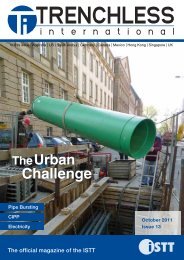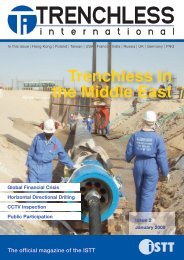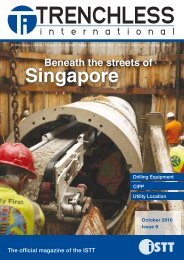tunnel's - Trenchless International
tunnel's - Trenchless International
tunnel's - Trenchless International
You also want an ePaper? Increase the reach of your titles
YUMPU automatically turns print PDFs into web optimized ePapers that Google loves.
Under Brazil<br />
<strong>Trenchless</strong> <strong>International</strong> interviewed Associação Brasileira de Tecnologia não Destrutiva Chairman Paulo<br />
Dequech about Brazil’s utilities, upcoming events, Affiliated Society, and projects.<br />
According to Associação Brasileira de Tecnologia não<br />
Destrutiva (ABRATT) Chairman Paulo Dequech, the majority<br />
of Brazil’s underground water and wastewater assets range<br />
between 80- and 40-years-old. Currently, the condition of<br />
Brazil’s water pipelines are very badly deteriorated, and consist<br />
of pipes made of cast iron, steel and from more recent<br />
installations, PVC. Wastewater pipelines are in a worse condition<br />
than water pipelines, and are comprised mostly of clay, concrete<br />
and cast-iron.<br />
The renewal of underground assets is becoming a high priority<br />
to the Brazil Government, particularly in major urban centres.<br />
Sabesp, for example, has its own assets renewal program<br />
supported by JICA from Japan. The company intends to replace<br />
all old water pipeline networks over the next three years.<br />
In progressing this project, the next step will be to rehabilitate the<br />
large watermain located in downtown São Paulo. The government<br />
also intends to start the rehabilitation of large diameter sewers as<br />
soon as appropriate funding is allocated.<br />
Brazil<br />
October 2012 - <strong>Trenchless</strong> <strong>International</strong><br />
Water and wastewater issues<br />
Mr Dequech says Brazil has highly experienced contractors and<br />
engineering companies, who have the material, man-power and<br />
technology to rehabilitate and upgrade Brazil’s infrastructure, but<br />
there is a lack of government funding in the areas of water and<br />
wastewater.<br />
Brazil’s upcoming projects<br />
The biggest sewer project currently underway in the region is the<br />
Tiete River Remediation Program in São Paulo. The project has so<br />
far utilised horizontal directional drilling (HDD) and microtunnelling,<br />
with both techniques proving highly successful in their installations.<br />
Mr Dequech says Brazil has large demands for upgrading sewer<br />
networks with thousands, perhaps even millions, of kilometres<br />
requiring installation throughout the country. He predicts that<br />
<strong>Trenchless</strong> Technology will be required on the majority of jobs.<br />
Tietê River Remediation Program<br />
In the period from 1900 to 2010, São Paulo’s population<br />
grew to 10.65 million inhabitants. If the wider metropolitan<br />
area is included with its 38 municipal districts, São Paulo has a<br />
population of 19 million.<br />
This rapid increase in the city’s population gave rise to a number<br />
of infrastructure challenges, including traffic jams, floods, and<br />
problems with sewage treatment and water supply.<br />
Today, 85 per cent of houses are connected to the collection<br />
network in greater São Paulo. The total length of the sewage<br />
network is currently 44,600 km, including 490 treatment plants<br />
Project crew working on the Project Tietê.<br />
and 5.8 million house connections. The city’s sewage treatment<br />
capacity stands at 43,500 litres per second.<br />
In October 1990, Project Tietê was launched to improve the<br />
wastewater network and clean the highly polluted 1,000 km long<br />
Tietê River, which runs through São Paulo.<br />
The first phase of Project Tietê ran from 1992–1998, and<br />
included the construction of 1.5 km of collection networks and 315<br />
km of trunk collectors, which expanded the collection network to<br />
serve 250,000 families.<br />
Quick facts on the Tietê River Remediation<br />
Program<br />
Project Operator: Sabesp<br />
Total length of sewer: Approximately 90 km<br />
Length of HDD drive: 5 per cent of total sewer length<br />
Length of microtunnelling drive: 95 per cent of<br />
total length<br />
Fund Agency: World Bank (50-60 per cent) and<br />
Sabesp (50-40 per cent).<br />
The mts1500S4 in action on the Project Tietê.<br />
The second phase of Project Tietê, 2002–2008, saw the<br />
installation of 165 km of trunk collectors, 1,426 km of collection<br />
networks and the cleaning of the Pinheiros River.<br />
The third and final phase of the project started in 2009 and is set<br />
to be completed in 2015. This phase will involve the construction<br />
of 580 km of trunks, collectors and interceptors; 1,250 km of<br />
collection networks; 200,000 household sewage connections and<br />
three new treatment plants. The primary goals of this phase are to<br />
increase wastewater collection from 85 per cent to 87 per cent,<br />
and to raise sewerage treatment from 72 per cent to 84 per cent.<br />
The project is utilising a mts Perforator excavator in the third<br />
phase of the project.<br />
São Paulo’s water utility: Sabesp<br />
The predominant stakeholder for water management in São<br />
Palo is Sabesp, a mixed capital company responsible for water<br />
supply and sewage collection and treatment in 363 municipalities<br />
in the state. Sabesp is one of the largest<br />
sanitation companies in the world in terms<br />
of population covered.<br />
Sabesp was created in 1973 to implement<br />
the National Sanitation Plan (PLANASA) – a<br />
Brazilian Government program that financed capital investments<br />
and helped develop state water and sewage companies, using<br />
funds from the FGTS (Workers’ Severance Pay Fund). Since then,<br />
other publicly – or state-owned companies related to water supply<br />
and sewage collection and treatment in the state have been<br />
merged into Sabesp.<br />
In partnership with private companies, Sabesp also operates<br />
in four other municipalities, Mogi-Mirim, Castilho, Andradina and<br />
Mairinque, in addition to providing advisory services in Panama<br />
and Honduras. It also maintains partnerships with the state<br />
sanitation concessionaires in Alagoas and Espírito Santo.<br />
Currently, 27.6 million people are supplied with water and<br />
20.5 million with sewage collection.<br />
In addition to basic sanitation, Sabesp is also equipped to<br />
provide drainage, urban cleaning, solid waste handling and<br />
energy services.<br />
In order to ensure high-quality services, the company maintains<br />
a massive structure and has invested around $US4.433 billion<br />
over the last five years.<br />
Between 2012 and 2015, it plans to invest a further $US3.94 billion<br />
to ensure that it advances towards its commitment to provide water<br />
and sewage services to everyone in its operational area by 2018.<br />
Brazil<br />
October 2012 - <strong>Trenchless</strong> <strong>International</strong><br />
14<br />
15
















